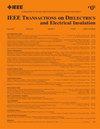Influence of 16–30-kHz Sinusoidal Voltage on Surface Discharge Characteristics at Different Pressures
IF 2.9
3区 工程技术
Q2 ENGINEERING, ELECTRICAL & ELECTRONIC
IEEE Transactions on Dielectrics and Electrical Insulation
Pub Date : 2024-09-05
DOI:10.1109/TDEI.2024.3454565
引用次数: 0
Abstract
Due to the specific communication requirements of high-altitude platforms, such as research institutes and monitoring stations in mountainous areas, as well as aircraft, voltage sources operating within very low-frequency (VLF) range (specifically between 16 and 30 kHz) are frequently utilized. High-frequency and high-voltage conditions increase the risk of surface discharge, posing a significant threat to the normal operation of high-voltage equipment. The existing insulation designs often refer to power frequency test results under low-pressure conditions, which often lead to insulation failures. Previous research has primarily focused on the effects of power frequency or voltage below 2 kHz on insulation characteristics at atmospheric pressure. In this work, we have built an insulation test platform to conduct surface discharge experiments at both power frequency and VLF. The pressure range is 20–60 kPa. The surface discharge inception voltage (SDIV) and breakdown voltage (BDV) of epoxy resin and polytetrafluoroethylene (PTFE) boards are investigated under highly nonuniform fields. The experimental results show that the SDIV of epoxy resin under VLF voltage is lower than that at 50 Hz, while PTFE exhibits a similar SDIV under different frequencies. Both insulation materials exhibit significantly lower BDV at VLF compared to those at 50 Hz. As the pressure decreases, both the SDIV and BDV decrease. Furthermore, we have analyzed how pressure and frequency affect surface discharge in insulation boards by means of the equivalent capacitance-resistance model and ion transport model. This study provides a reference for the insulation design of high-voltage power supplies for VLF communication equipment under low-pressure conditions.16 kHz-30 kHz 正弦电压对不同压力下表面放电特性的影响
本文章由计算机程序翻译,如有差异,请以英文原文为准。
求助全文
约1分钟内获得全文
求助全文
来源期刊
CiteScore
6.00
自引率
22.60%
发文量
309
审稿时长
5.2 months
期刊介绍:
Topics that are concerned with dielectric phenomena and measurements, with development and characterization of gaseous, vacuum, liquid and solid electrical insulating materials and systems; and with utilization of these materials in circuits and systems under condition of use.

 求助内容:
求助内容: 应助结果提醒方式:
应助结果提醒方式:


